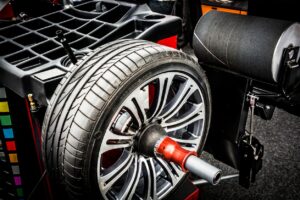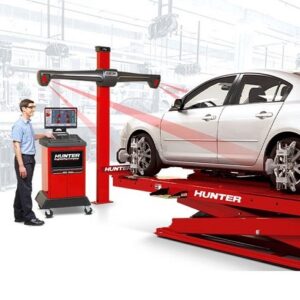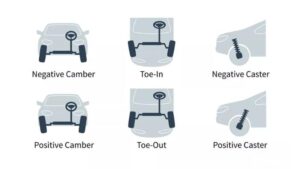As we discussed in our previous blog, hitting a pothole can wreak havoc on your vehicle’s suspension, tires, and alignment. While we can’t always avoid potholes, we can take proactive measures to mitigate the damage they cause. One such measure is ensuring your tires are properly balanced and your wheels are correctly aligned. In this week’s video, John breaks down the difference between tire balancing and wheel alignments and why our cars need them.
What is a Tire Balance?
Tire balancing involves evenly distributing the weight of the tire and wheel assembly. This is done by attaching small weights to the rim of the wheel to counterbalance any heavy spots. All of our locations use Hunter Engineerings Road Force Tire Balancing machines to mimic your vehicle driving on a road to achieve the most precise balance possible for your vehicle.

Why Do We Perform a Tire Balance?
Balanced tires ensure smooth and even tire wear, leading to a comfortable ride and improved tire life. Unbalanced tires can cause vibrations, uneven tread wear, and steering issues, compromising both safety and performance. After hitting a pothole, it’s very common to balance your tires to reverse any damage the pothole may have caused.
What is a Wheel Alignment?
Wheel alignment refers to adjusting the angles of the wheels to the manufacturer’s specifications. This ensures that the tires make proper contact with the road surface and are aligned with each other. We use Hunter Engineerings Hawkeye Alignment Machine to align your vehicle to the precise measurements each manufacturer specifies.

Why Do We Perform a Wheel Alignment?
A proper wheel alignment ensures optimal handling, stability, and tire longevity. Misaligned wheels can lead to uneven tire wear, pulling to one side, and decreased fuel efficiency. Wheels that are not aligned can drastically increase your tire wear, for this reason we recommend having an alignment performed whenever you mount a new set of tires to your wheels. If you feel your vehicle is out of alignment, have your trusted professional perform an alignment check.

Do I Need A Wheel Alignment Or a Tire Balance?
Determining whether your car needs a tire balance or a wheel alignment depends on the symptoms you’re experiencing. If you’re feeling vibrations or noticing uneven tire wear, a tire balance may be needed. However, if your car pulls to one side or the steering feels off-center, a wheel alignment is likely necessary.
Here Are The Key Warning Signs to Look Out For:
– Vibrations in the steering wheel or seat
– Uneven or rapid tire wear
– Pulling to one side while driving
– Steering wheel not centered when driving straight
– Difficulty handling the vehicle or maintaining a straight line
Tire balancing and wheel alignment are essential maintenance procedures that contribute to a safe and enjoyable driving experience. By understanding the differences between these two services and recognizing the warning signs of imbalance or misalignment, you can stay ahead of potential issues and keep your car running smoothly. If you’re experiencing any of the warning signs mentioned, don’t hesitate to visit one of our auto shops for a thorough inspection and necessary adjustments.
Safe travels
0 Comments